Blade Runner
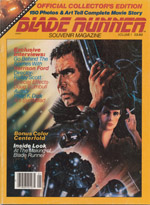 |
Blade Runner Souvenir Magazine, vol. 1. New York: Ira Friedman, 1982. [zoom] | Additional images:   
The official Blade Runner magazine features excerpts from an interview with Dick conducted shortly before his death. A caption beneath a photo of Dick states that he “worked closely with the Blade Runner producers until his untimely passing.” In fact, Dick had publicly stated his irritation that the film’s producers had excluded him from the film’s pre-production, and disparaged both an early draft of the screenplay and Ridley Scott’s earlier film Alien. He recanted after seeing a later draft, and though he died before seeing the finished film, he was impressed by a sample reel of effects footage that he saw in December 1981. Dick allegedly told the effects team: “The environment is exactly as how I’d imagined it! How’d you guys do that?” |
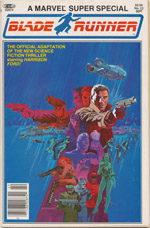 |
Marvel Comics Super-Special #22: Blade Runner. Script by Archie Goodwin; pencils by Al Williamson and Carlos Garzon; Inks by Al Williamson, Dan Green, and Ralph Reese. New York: Marvel Comics Group, 1982. [zoom] | Additional images: 
Marvel Comics’ adaptation of Blade Runner featured art by Al Williamson, a prominent illustrator of science fiction comics who had previously provided art for Marvel’s adaptation of The Empire Strikes Back (also featuring Harrison Ford). The cover art for Marvel Super-Special #22 is by Jim Steranko, whose revolutionary comics art in the late ’60s brought elements of surrealism and pop art to superhero and spy stories. By the 1980s he had largely retired from comics, working more as a commercial artist and cover illustrator. Prior to painting this cover, he had worked as a conceptual artist on Raiders of the Lost Ark, and is generally credited with designing the appearance of Indiana Jones. |
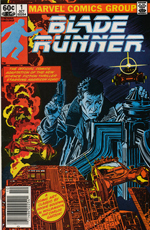 |
Blade Runner #1-2. Script by Archie Goodwin; pencils by Al Williamson and Carlos Garzon; Inks by Al Williamson, Dan Green, and Ralph Reese. New York: Marvel Comics Group, 1982. [zoom] | Additional images: 
After the publication of Marvel Super-Special #22, the adaptation was reprinted as a two-issue miniseries. |
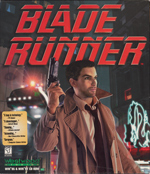 |
Blade Runner [Video Game]. Las Vegas, Nev.: Westwood Studios, 1997. [zoom] This PC video game tells a story that runs parallel to that of the film Blade Runner. The game’s 3-D graphics were ambitious for its time, and it was nominated for “Best Adventure Game” of 1997 by PC Gamer magazine. This was the second Blade Runner video game; it was preceded by a 1985 game for the Commodore 64 that, due to complex rights entanglements, was nominally based on Vangelis’s film score rather than the film itself. |
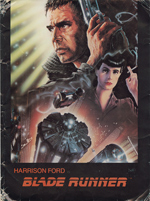 |
Blade Runner [Press Kit]. Los Angeles, Calif.: The Ladd Company/Warner Brothers, 1982. [zoom] | Additional images:      
At the time of Blade Runner’s release, the assembly of press kits was somewhat haphazard, and it is rare for two to be identical. This kit contains 20 black-and-white still photographs from the film in a full-color folder illustrated with John Alvin’s poster art. |
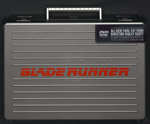 |
Blade Runner: The 5-Disc Complete Collector’s Edition. Burbank, Calif.: Warner Home Video, 2007. [zoom] | Additional images:   
The production of Blade Runner was tense, and neither the director nor the producers were pleased with the version released in 1982. In notes from a screening of an early cut of the film, co-executive producer Jerry Perenchio stated “This picture gets duller every time we see it.” Audiences at the time agreed, and the film was a flop. But its growing cult status and popularity on home video has allowed it the opportunity for a second chance with Ridley Scott’s 1992 “Director’s Cut.” Blade Runner’s 25th anniversary was celebrated in 2007 with a deluxe five-disc DVD release containing five different versions of the film, including a brand-new “final cut” more accurately representing Ridley Scott’s intentions for the picture. Also included are the replicas of Deckard’s spinner car and Gaff’s origami unicorn shown here. |